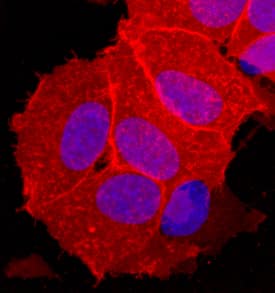Human OBCAM/OPCML Antibody
R&D Systems, part of Bio-Techne | Catalog # AF2777

Key Product Details
Species Reactivity
Validated:
Cited:
Applications
Validated:
Cited:
Label
Antibody Source
Product Specifications
Immunogen
Gly28-Asn322
Accession # Q14982
Specificity
Clonality
Host
Isotype
Scientific Data Images for Human OBCAM/OPCML Antibody
OBCAM/OPCML in MCF‑7 Human Cell Line.
OBCAM/OPCML was detected in immersion fixed MCF-7 human breast cancer cell line using Goat Anti-Human OBCAM/OPCML Antigen Affinity-purified Polyclonal Antibody (Catalog # AF2777) at 10 µg/mL for 3 hours at room temperature. Cells were stained using the NorthernLights™ 557-conjugated Anti-Goat IgG Secondary Antibody (red; Catalog # NL001) and counterstained with DAPI (blue). Specific staining was localized to cell surfaces. View our protocol for Fluorescent ICC Staining of Cells on Coverslips.Applications for Human OBCAM/OPCML Antibody
CyTOF-ready
Flow Cytometry
Sample: NG108-15 mouse neuroblastoma/rat glioma hybrid cell line
Immunocytochemistry
Sample: Immersion fixed NG108-15 mouse neuroblastoma/rat glioma hybrid cell line and immersion fixed MCF-7 human breast cancer cell line
Immunohistochemistry
Sample: Immersion fixed paraffin-embedded sections of human brain (cortex)
Western Blot
Sample: Recombinant Human OBCAM (Catalog # 2777-CM)
Formulation, Preparation, and Storage
Purification
Reconstitution
Formulation
Shipping
Stability & Storage
- 12 months from date of receipt, -20 to -70 °C as supplied.
- 1 month, 2 to 8 °C under sterile conditions after reconstitution.
- 6 months, -20 to -70 °C under sterile conditions after reconstitution.
Background: OBCAM/OPCML
OBCAM (Opioid-binding cell adhesion molecule, also known as OPCML) is a member of the IgLON family of cell adhesion molecules. All IgLONs are GPI-linked glycoproteins, contain three C2 type Ig-like domains, and are expressed in cerebral cortex and hippocampus (1, 2). The name IgLON derives from family membership in the Ig superfamily, and the first letters of the names of group’s molecules; LAMP, OBCAM, and Neurotrimin. Recently, membership in the group has been expanded by one with the addition of Kilon (Kindred of IgLON), and members of this group are now often referred to Diglons, based on the dimerizing nature of the IgLONs (1, 2). Human OBCAM is synthesized as a 345 amino acid (aa) preproprecursor that contains a 27 aa signal sequence, a 295 aa mature region, and a C‑terminal 23 aa prosegment (3). The prosegment is cleaved to generate the GPI-link. OBCAM varies in molecular weight, ranging from 46 kDa to 65 kDa (4‑6). The difference is not due to alternate splicing but to differential glycosylation (6). Although it is not unusual for GPI-linked proteins to be solubilized, to date there is no evidence that OBCAM functions as a soluble molecule (1). Mature human OBCAM is 98%, 99%, and 98% aa identical to mature bovine, rat and mouse OBCAM, respectively. OBCAM has limited expression, occurring principally in telencephalon and ovarian epithelium (7, 8). In brain, it is found associated with dendrites and post-synaptic membranes, where it may maintain synaptic architecture (1, 5). In ovary, it has been suggested to be a tumor-suppressor factor (8). The receptor(s) for OBCAM appears to be other members of the IgLON family, and a dimer is the functional unit. While neurotrimin appears to function as both a homodimer and heterodimer, all other family members (including OBCAM) show a preference for heterodimerization. OBCAM forms strong trans (between cells) heterodimers with LAMP, and modest heterodimers with Neurotrimin. There is hardly any binding with itself. Kilon likely binds OBCAM, but this interaction is not well studied (1). OBCAM heterodimers apparently bind to almost all possible IgLON heterodimer combinations on other cells. In cis (same cell), OBCAM also binds to LAMP and Neurotrimin (2).
References
- Miyata, S. et al. (2000) Neuroscience 117:645.
- Reed, J. et al. (2004) J. Cell Sci. 117:3961.
- Shark, K.B. and N.M. Lee (1995) Gene 155:213.
- Wick, M.J. et al. (1996) Mol. Brain Res. 36:322.
- Miyata, S. (2000) J. Comp. Neurol. 242:74.
- Hachisuka, A. et al. (1996) Neurochem. Int. 28:373.
- Miyata, S. et al. (2003) Brain Res. 979:129.
- Sellar, G.C. et al. (2003) Nat. Genet. 34:337.
Long Name
Alternate Names
Gene Symbol
UniProt
Additional OBCAM/OPCML Products
Product Documents for Human OBCAM/OPCML Antibody
Product Specific Notices for Human OBCAM/OPCML Antibody
For research use only
